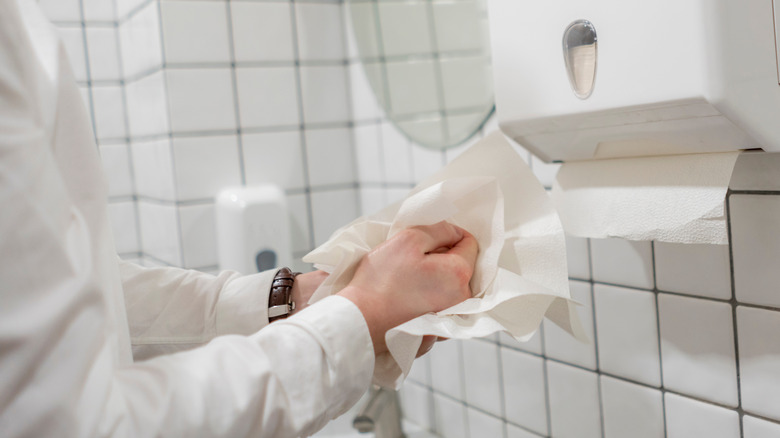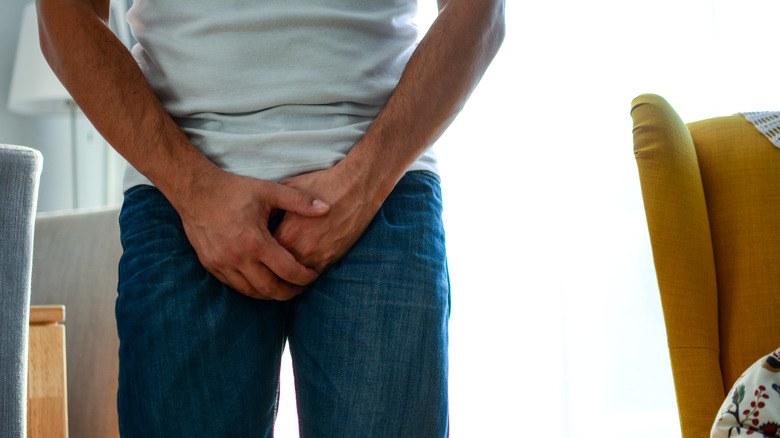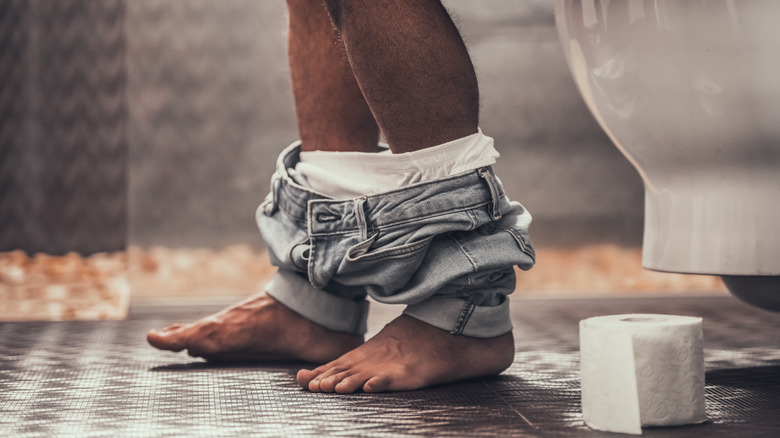Sitting Down To Pee Has An Unexpected Effect On Men's Health
People without penises (and not-so-great at squatting/hovering abilities) often look at the ability to pee without having to touch the toilet surface as remarkable, or even enviable sometimes. Think about that time when you were faced with a less-than-sanitary public washroom situation and you just had to go, well, because holding in your pee is riskier than you think.
But turns out that sitting down to pee has unexpected health benefits, even for men. And yes, a surprising number of men apparently agree that have used this method of relieving themselves, according to a 2023 YouGov UK survey. Germans came out on top as having the highest percentage of men who consistently sat down to urinate (40%), followed by Sweden and Denmark with 22% and 19% respectively.
Butt-to-toilet seat contact while peeing can help you empty your bladder fully, according to a 2014 study published in PLOS ONE. Standing while peeing means you're still engaging the muscles in your pelvis and spine, which means they're not as relaxed. Plus, "when you sit down, you can use your abdominal muscles more, and you get your last few squirts out and feel like you've emptied better," explained associate clinical professor at the UCLA Department of Urology Dr. Jesse N. Mills (via Thrillist).
Sitting down to pee can benefit prostate conditions
In addition to being a great option for those times when your legs are just tired and want a rest, sedentary peeing is also great for those times when men experience after-dribble when peeing (no unnecessary splashes) or when peeing habits change as men age.
Prostate conditions like benign prostatic hyperplasia (BPH) — which basically refers to an enlarged prostate that happens with age and hormonal changes — can cause disruptions to urine flow. "You get an increase in a certain breakdown product of testosterone which causes the prostate to increase its cell development and size. As a result of this, men start to find they can pee much better sitting down," explained a consultant urological surgeon at the Alexandra Hospital, Gerald Collins (via The Telegraph).
Plus, let's face it, when the conditions are right (we're talking a clean-smelling bathroom and sanitary toilet seat), sitting down to pee can give you a few moments to relax while also helping you aim better into the toilet bowl. Also, in case your body decides that it wants to go number two, no problem — you're already seated anyway. But we get it, sitting down to pee is not everyone's new favorite thing, good health effects or not.
How you pee all comes down to personal preference
Whether we like it or not, our mind is involved in the process of peeing too. In fact, a 2014 study published in eLife found that both your brain and your bladder are involved in the reflexes and conscious control of urine. This probably explains why some people experience the unexpected effect of not being able to pee when they're hovering over a public toilet. If you're not used to the exercise, it can take a little time for your brain to tell your bladder it's okay to relieve yourself.
Men could feel the same way if there's shame attached to sitting down to pee or if they've always peed standing up. Humans tend to do what's most comfortable for them. Per an older study published in Neurourology and Urodynamics done on healthy adult men without lower urinary tract symptoms, the flow of urine parameters were higher in those who stood or squatted to pee, as opposed to those who sat down to relieve themselves, suggesting that familiarity might have something to do with it.
Either way, choosing to pee standing, squatting, or sitting down is your personal choice. If a prostate condition or related urinary tract issue is causing dribbling pee or the sensation that you've not fully emptied your bladder, perhaps you can try sitting down. That being said, if you're noticing unexpected or concerning changes with how your urine is coming out of you — dribbling, starting and stopping, or after-dribble — you should get that checked by a healthcare provider.



